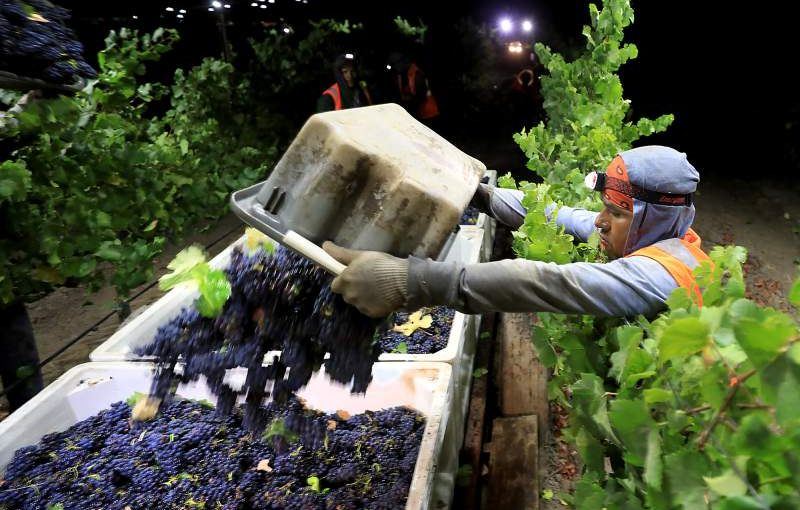
Harvest kicked off early Wednesday in Sonoma and Napa counties, where workers fanned out in the cool, pre-dawn darkness to begin retrieving the region’s prized grape crop and transform it into some of the most coveted wines in the world.
The first grapes mark the beginning of the busiest time of year in Wine Country. Workers will toil around the clock over the next 10 weeks to pick, crush and ferment the 2018 vintage, which took longer to ripen this summer, compared to other recent crops, but is expected to be equally as bountiful.
Work crews were out around 2 a.m. at the Kiser Vineyard just south of Sonoma along Highway 12 to pick a five-acre parcel dedicated to pinot noir grapes. Seven hours later, the fruit was trucked over to the nearby Gloria Ferrer Caves and Vineyards, where it was pressed into juice that will go into sparkling wine. Those bottles will be on store shelves in 2021.
“I would say we are on the normal (yield) side from the growing standpoint,” said Steve Sangiacomo, who manages the vineyard. “We’re later than the last few years, but they (previous harvests) have been on the early side.”
Last year, harvest started July 28 for a crop that was ultimately valued at $1.5 billion from vineyards in Sonoma, Napa, Mendocino and Lake counties. Those vineyards produced 467,157 tons of grapes, about 1 percent above the 10-year average for the region.
The 2017 harvest was noted for a Labor Day weekend heat spike that sent winemakers scrambling to pick their fruit or risk the grapes shriveling on the vines. A few weeks later, wildfires in early October forced some growers to let their crops rot because they were evacuated from fire zones. There is concern that some late red varietals picked after the 2017 wildfires could suffer from smoke taint.
Gloria Ferrer winemaker Steve Urberg said he was pleased so far with an uneventful growing season that featured a mild winter, timely spring rains and summer heat without any wild temperature swings.
The yield for the chardonnay crop looks about normal, Urberg said, while the pinot noir crop is above average.
“The fruit looks great,” he said. “We didn’t have any difficulties with weather or mildew or heat spikes. Everything rode through very nicely.”
Harvest begins slow, when crews first pick pinot noir and chardonnay grapes for sparkling wine because they are at a lower sugar level needed for fermentation of the bubbly. But it will soon pick up speed as grapes used to make chardonnay and pinot noir ripen. Crush will likely run through the end of October, when the last of the red varietals such as cabernet sauvignon and merlot are picked.
Over at Iron Horse Vineyards in Sebastopol, workers picked 9 tons of pinot noir grapes that will go into its sparkling wine for the 42nd harvest of the family-owned winery, said Joy Sterling, chief executive officer.
“The fruit is just exquisite and tastes delicious,” Sterling said.
The winery was encouraged that yields from the block picked on its estate vineyards Wednesday were 20 percent larger than last year, indicating a bigger crop, she said.
Other local wineries also picked their grapes on Wednesday, including more than 70 tons of chardonnay in Cloverdale for Rack & Riddle winery’s sparkling wine portfolio and Mumm Napa picked pinot noir over at the Oak Knoll area of the Napa Valley.
One concern heading into harvest has been smoke from the Mendocino Complex fires. It has predominantly been an issue in Lake County, where a smoky haze has covered the sky for the past two weeks.
Lake County growers and winemakers who source from the area are keeping a watchful eye on whether the crop could be susceptible to smoke taint. Some analysts contend the fruit is most susceptible to such taint between veraison — the visual onset of ripening — and harvest. Beckstoffer Vineyards, one of the largest landowners in Lake County, plans to test its grapes to determine if the fruit has been affected.
“There is certainly a concern. There is certainly talk,” said Brian Clements, vice president at Turrentine Brokerage in Novato. “It’s complicated at this point in time. No. 1, is there going to be an issue? Then, if so, how are we going to go about to remedy the issue?”
